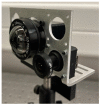Wide-Field-of-View Multispectral Camera Design for Continuous Turfgrass Monitoring
- PMID: 36904674
- PMCID: PMC10007062
- DOI: 10.3390/s23052470
Wide-Field-of-View Multispectral Camera Design for Continuous Turfgrass Monitoring
Abstract
Sustainably using resources, while reducing the use of chemicals, is of major importance in agriculture, including turfgrass monitoring. Today, crop monitoring often uses camera-based drone sensing, offering an accurate evaluation but typically requiring a technical operator. To enable autonomous and continuous monitoring, we propose a novel five-channel multispectral camera design suitable for integrating it inside lighting fixtures and enabling the sensing of a multitude of vegetation indices by covering visible, near-infrared and thermal wavelength bands. To limit the number of cameras, and in contrast to the drone-sensing systems that show a small field of view, a novel wide-field-of-view imaging design is proposed, featuring a field of view exceeding 164°. This paper presents the development of the five-channel wide-field-of-view imaging design, starting from the optimization of the design parameters and moving toward a demonstrator setup and optical characterization. All imaging channels show an excellent image quality, indicated by an MTF exceeding 0.5 at a spatial frequency of 72 lp/mm for the visible and near-infrared imaging designs and 27 lp/mm for the thermal channel. Consequently, we believe our novel five-channel imaging design paves the way toward autonomous crop monitoring while optimizing resource usage.
Keywords: camera design; demonstrator setup; modulation transfer function; multispectral camera; thermal imaging; turfgrass monitoring; vegetation indices; wide field of view.
Conflict of interest statement
The authors declare no conflict of interest.
Figures













References
-
- European Court of Auditors . Sustainable Water Use in Agriculture. European Court of Auditors; Luxembourg: 2021.
-
- European Commission Sustainable Use of Pesticides. [(accessed on 24 June 2022)]. Available online: https://ec.europa.eu/food/plants/pesticides/sustainable-use-pesticides_en.
-
- Deng L., Mao Z., Li X., Hu Z., Duan F., Yan Y. UAV-Based Multispectral Remote Sensing for Precision Agriculture: A Comparison between Different Cameras. ISPRS J. Photogramm. Remote Sens. 2018;146:124–136. doi: 10.1016/j.isprsjprs.2018.09.008. - DOI
-
- Hong M., Bremer D.J., van der Merwe D. Thermal Imaging Detects Early Drought Stress in Turfgrass Utilizing Small Unmanned Aircraft Systems. Agrosyst. Geosci. Environ. 2019;2:1–9. doi: 10.2134/age2019.04.0028. - DOI
-
- Nebiker S., Annen A., Scherrer M., Oesch D. A Light-Weight Multispectral Sensor for Micro UAV–Opportunities for Very High Resolution Airborne Remote Sensing. Int. Arch. Photogramm. Remote Sens. Spat. Inf. Sci. 2008;XXXVI:1193–1200.
Grants and funding
LinkOut - more resources
Full Text Sources
Miscellaneous

